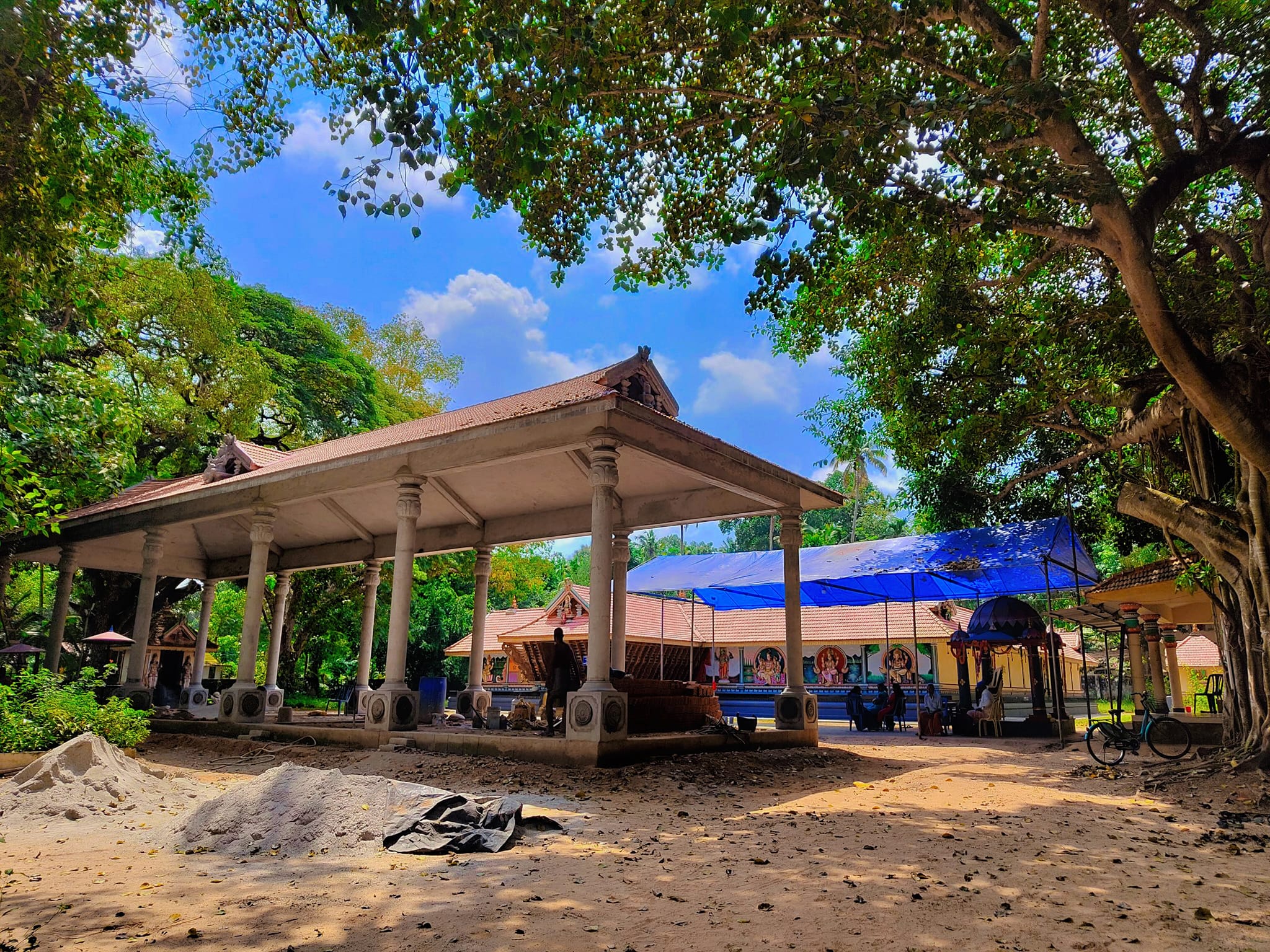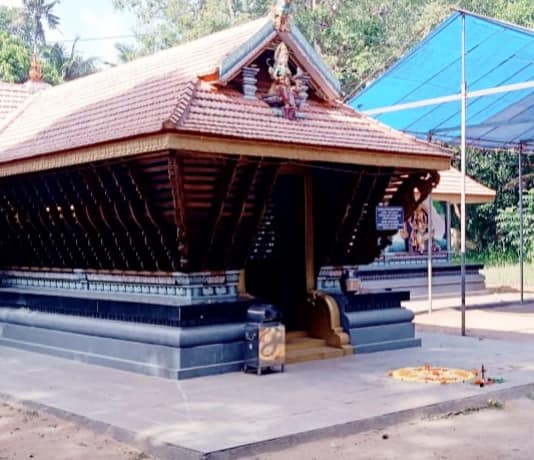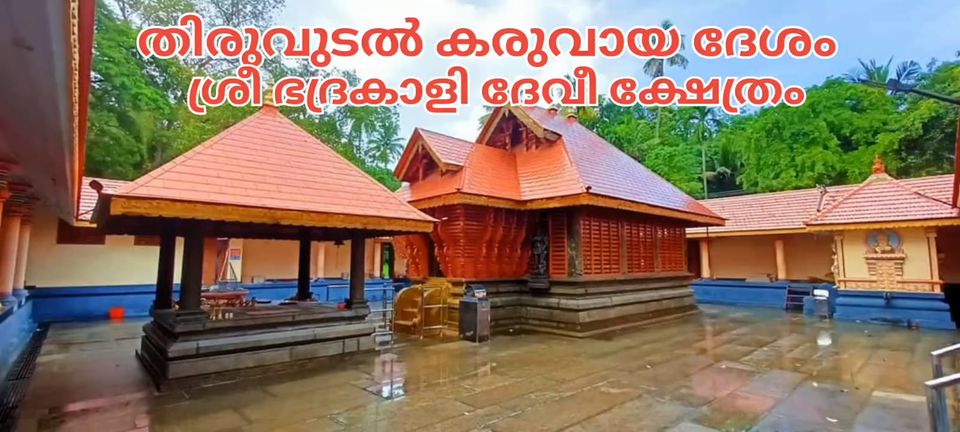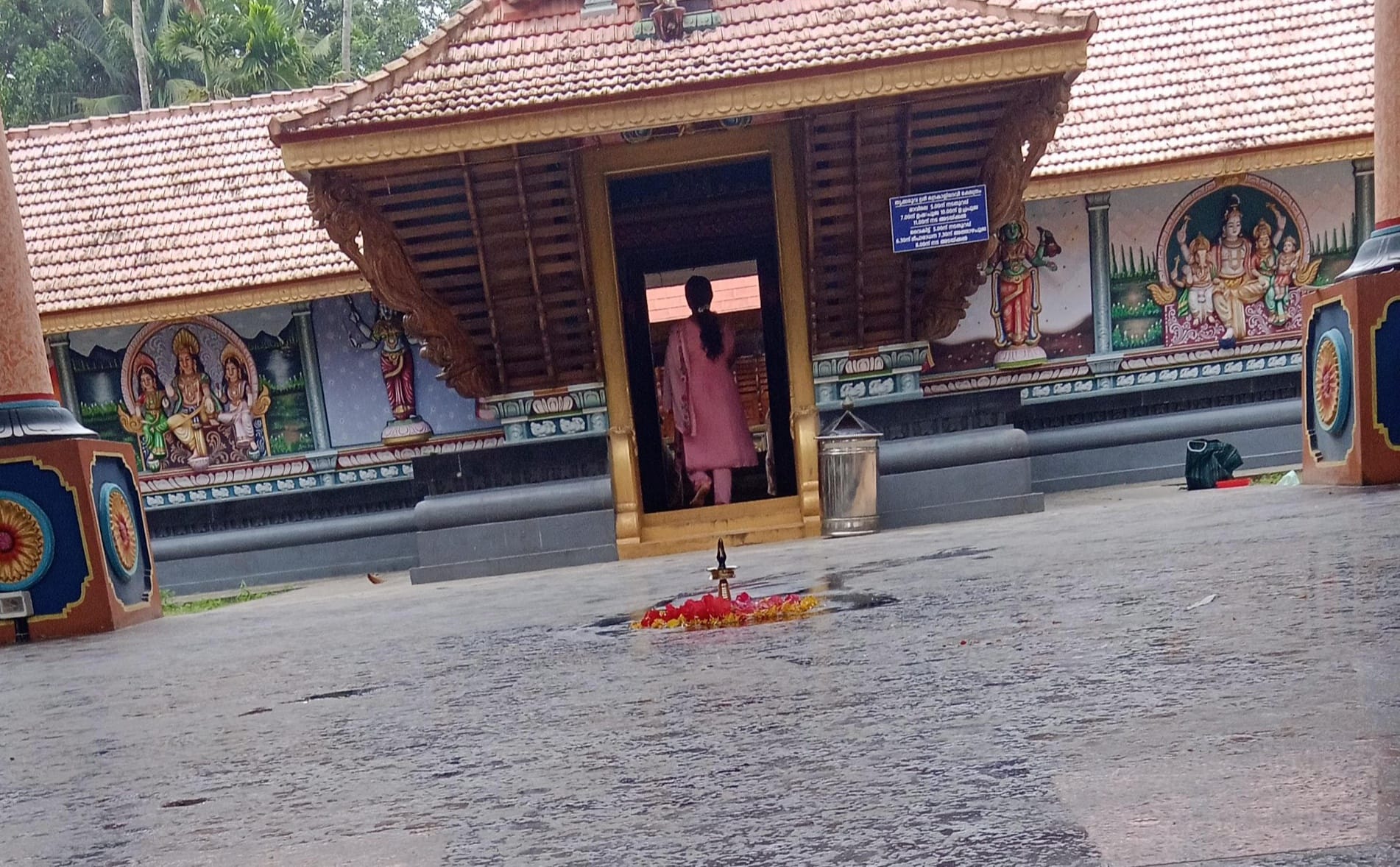Thrikkaruva Sree Bhadrakali Temple is located in Thrikkaruva, within the Kollam district. Thrikkaruva is approximately 10 kilometers from Kollam City, and the temple itself is situated 1.3 kilometers from the center of Thrikkaruva.

Thrikarua Sri Bhadrakali Devi Temple and Ashtamudi Sri Veerabhadraswamy Temple are among the most ancient temples located in the Kollam district. These temples hold significant religious and historical importance, particularly in relation to the Daksha Yaga and Daksha nigraha as described in the Shiva Purana. The Devi Pratishta is situated next to the Daru Bimbam, which is a five-foot tall primary idol of the Goddess, intricately carved from Varikaplavin wood (Jackfruit tree) in the fierce representation of Goddess Sri Bhadrakali, oriented towards the north. According to legend, a north-facing Goddess Bhadrakali is believed to embody fury.
Such a deity, depicted in the Daru form, is exceptionally rare within Kerala. The Thrikaruva Bhadrakali Devi Temple and the Ashtamudi Sri Veerabhadra Swamy Temple, along with their surrounding areas, served as the primary centers for local Mahotsavam celebrations in Trikarua. The book "Trikaruva Devaswom," which chronicles the temple's history, details the Kuruthi Mahotsavam occurring in the month of Scorpio (Vruschikam) and the Kumbhabharani Mahotsavam at the Trikaruva Temple. Throughout the month of Scorpio, the temple precincts were vibrant with festivities. Daily celebrations included Bhadrakali Pattu (Thotam Pattu). The six regions involved were Nduvilamcheri, Vaddakekara, Ashtamudi, Prakulam, Inchavila, and Thekencheri, where performances for the first four days were conducted by Devaswom and subsequent days featured various song artists. Kathakali performances took place in multiple venues starting at 10 PM. The Kuruthi Vrishchikotsavam concluded with a Pooja on the 30th of Vruschikam.
Additionally, on the twenty-eighth day of Onam, the UrulNercha Mahotsav at the Ashtamudi Sri Veerabhadra Swamy Temple included a boating competition in the Ashtamudi backwaters. The Thrikaruva Bhadrakali Devi Temple and the Ashtamudi Sri Veerabhadra Swamy Temple, along with their surrounding areas, served as the primary centers for local Mahotsavam celebrations in Trikarua. The book "Trikaruva Devaswom," which chronicles the temple's history, details the Kuruthi Mahotsavam that occurs during the month of Scorpio (Vruschikam) and the Kumbhabharani Mahotsavam at the Trikaruva Temple. Throughout the month of Scorpio, the temple precincts were vibrant with festivities. Daily celebrations included Bhadrakali Pattu (Thotam Pattu).
The six regions involved were Nduvilamcheri, Vaddakekara, Ashtamudi, Prakulam, Inchavila, and Thekencheri, where performances for the first four days were conducted by Devaswom and various song artists on subsequent days. Kathakali performances took place in numerous venues starting at 10 PM. The Kuruthi Vrishchikotsavam concluded with a Pooja on the 30th of Vruschikam. Additionally, on the twenty-eighth day of Onam, the UrulNercha Mahotsav at the Ashtamudi Sri Veerabhadra Swamy Temple featured a boating competition in the Ashtamudi backwaters. The Mahotsavam was observed at the Trikarua Sri Bhadrakali Devi temple on the Ashwati and Bharani days during the month of Kumbham. Until the year 1891 AD, the local populace celebrated the Kumbhabharani Mahotsava at Mulakkal field, organized by Nedumkuthirayeduppu.
Six artisans from the temple would engage in a competition, presenting six horses, which would then be paraded around the temple before being arranged in a line in front of it. In addition to the principal deity, Sri Mahaganapati, who is positioned facing east in the southwest section of the nalampalam, there are several other deities present. Sri Mahadev is located in the northeast outside the nalampalam, while Sri Mahavishnu is situated in the southeast, and Srishasta is found in the southwest. Nagaraja is represented in Virgo, alongside Nagayakshi, Akhila Sarpas in Sagittarius, Vasurimala, Brahmarakshas, Kandakarna, Yaksha, Rajayakshi, and Yogishwara Swamy. The temple is also home to additional deities. On the northern side of the temple lies the Gurutikalam, with Madaswami facing the temple at the base of the palm tree positioned centrally within the Gurutikalam.
തൃക്കരുവാ ശ്രീ ഭദ്രകാളി ദേവീ ക്ഷേത്രം
ശിവ പുരാണത്തിലെ ദക്ഷയാഗവും ദക്ഷനിഗ്രഹവുമായി ബന്ധപ്പെട്ട ഐതിഹ്യവും പുണ്യപുരാതനതയും ചരിത്രപരമായ പ്രാധാന്യവും ഉള്ള കൊല്ലം ജില്ലയിലെ ഏറ്റവും പഴക്കമുള്ള രണ്ട് ക്ഷേത്രങ്ങളാണ് തൃക്കരുവ കുത്തിയഴികം ദേവസ്വം ഭരണയോഗത്തിന് കീഴിലുള്ള തൃക്കരുവാ ശ്രീ ഭദ്രകാളി ദേവീക്ഷേത്രവും അഷ്ടമുടി ശ്രീ വീരഭദ്രസ്വാമി ക്ഷേത്രവും. ശ്രീഭദ്രകാളി ദേവിയുടെ ഉഗ്രമൂർത്തി ഭാവത്തിലുള്ള ദാരു ബിംബം (ദാരു ബിംബം - വരിക്കപ്ലാവിൻ തടിയിൽ നിർമ്മിച്ച അഞ്ചടിയോളം ഉയരമുള്ള ദേവിയുടെ ഉഗ്രഭാവമുള്ള മൂല വിഗ്രഹം) കൂടിയതും വടക്കോട്ട് ദർശനമായതുമാണ് ഈ ദേവി പ്രതിഷ്ഠയുടെ പ്രത്യേകത.
(വടക്കോട്ട് ദർശനമായ ഭദ്രകാളി ദേവിയുടെ രൗദ്രഭാവം പുരാണങ്ങളിൽ പരാമർശിക്കപ്പെട്ടിട്ടുണ്ട്). ഇത്തരത്തിൽ വടക്കോട്ട് ദർശനവും ദാരു ബിംബത്തോടും കൂടിയ പ്രതിഷ്ഠ കേരളത്തിൽ വളരെ അപൂർവമാണ്. കുംഭ മാസത്തിലെ അശ്വതി, ഭരണി നാളിൽ തൃക്കരുവ ശ്രീ ഭദ്രകാളി ദേവി ക്ഷേത്രത്തിൽ മഹോത്സവം ആഘോഷിക്കപ്പെട്ടിരുന്നു. എ. ഡി 1891 വരെ മുളയ്ക്കൽ വയലിൽ നെടുംകുതിര എടുപ്പായിട്ടാണ് ദേശക്കാർ കുംഭഭരണി മഹോത്സവം ആഘോഷിച്ചിരുന്നത്. ക്ഷേത്രത്തിലെ ആറു കരക്കാർ മത്സരബുദ്ധിയോടെ നെടും കുതിരകളെ കൊണ്ടുവരും.
ആറു കുതിരകളെയും കൊണ്ടുവന്ന് ക്ഷേത്രത്തിന് പ്രദക്ഷിണം വെച്ച ശേഷം, ക്ഷേത്രത്തിന് മുന്നിൽ ഇവയെ നിരത്തിവയ്ക്കും. ദേവസ്വം അധികാരികളിൽ മൂത്ത കാരണവർ നാന്തകത്തിലും ചിലമ്പിലുമായി ആവാഹിച്ച ദേവിയെ ക്ഷേത്രത്തിന് പുറത്തേക്ക് എഴുന്നള്ളിക്കും. ആറ് കരക്കാരുടെയും നെടും കുതിരകളുടെ അകമ്പടിയോടെ ക്ഷേത്രത്തിന് വടക്കോട്ട് പുറപ്പെടുന്ന എഴുന്നള്ളത്ത് തോട് കടന്ന് കിഴക്ക് ഭാഗത്തുള്ള മുളക്കൽ ഏലായിലേക്കു ഇറങ്ങും. തുടർന്ന് എഴുന്നള്ളത്ത് ഏലായുടെ മധ്യഭാഗത്തുള്ള ആൽത്ത്. കുംഭ മാസത്തിലെ അശ്വതി, ഭരണി നാളിൽ തൃക്കരുവ ശ്രീ ഭദ്രകാളി ദേവി ക്ഷേത്രത്തിൽ മഹോത്സവം ആഘോഷിക്കപ്പെട്ടു. എ. ഡി 1891 വരെ മുളയ്ക്കൽ വയലിൽ നെടുംകുതിര എടുപ്പായിട്ടാണ് ദേശക്കാർ കുംഭഭരണി മഹോത്സവം ആഘോഷിച്ചിരുന്നത്.
ക്ഷേത്രത്തിലെ ആറു കരക്കാർ മത്സരബുദ്ധിയോടെ നെടും കുതിരകളെ കൊണ്ടുവരും. ആറു കുതിരകളെയും കൊണ്ടുവന്ന് ക്ഷേത്രത്തിന് പ്രദക്ഷിണം വെച്ച ശേഷം, ക്ഷേത്രത്തിന് മുന്നിൽ ഇവയെ നിരത്തിവയ്ക്കും. ദേവസ്വം അധികാരികളിൽ മൂത്ത കാരണവർ നാന്തകത്തിലും ചിലമ്പിലുമായി ആവാഹിച്ച ദേവിയെ ക്ഷേത്രത്തിന് പുറത്തേക്ക് എഴുന്നള്ളിക്കും. ആറ് കരക്കാരുടെയും നെടും കുതിരകളുടെ അകമ്പടിയോടെ ക്ഷേത്രത്തിന് വടക്കോട്ട് പുറപ്പെടുന്ന എഴുന്നള്ളത്ത് തോട് കടന്ന് കിഴക്ക് ഭാഗത്തുള്ള മുളക്കൽ ഏലായിലേക്കു ഇറങ്ങും. തുടർന്ന് എഴുന്നള്ളത്ത് ഏലായുടെ മധ്യഭാഗത്തുള്ള ആൽത്ത്.



